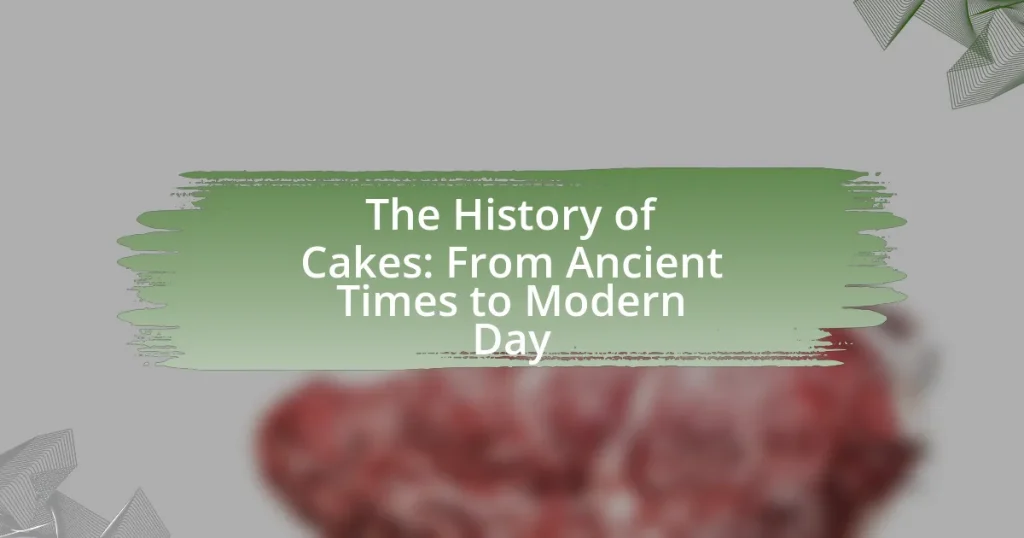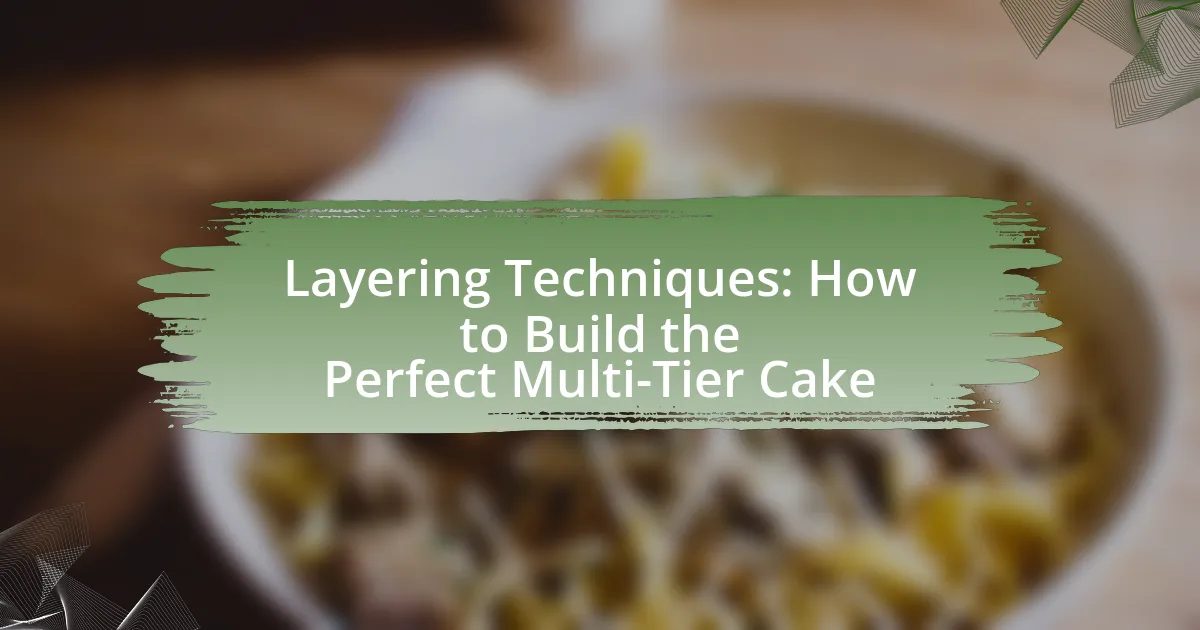The article explores the history of cakes, tracing their evolution from ancient civilizations to contemporary baking practices. It highlights the origins of cakes in ancient Egypt, the incorporation of ingredients like sugar and eggs during the Middle Ages, and the transformative impact of baking powder in the 19th century. The significance of cakes in cultural traditions and celebrations is examined, alongside the influence of modern dietary preferences and technological advancements on cake recipes and designs. Key milestones, iconic cakes, and contemporary trends in flavor and aesthetics are also discussed, providing a comprehensive overview of the cake’s journey through history.

What is the history of cakes?
The history of cakes dates back to ancient civilizations, where early forms of cakes were made from simple mixtures of flour, honey, and nuts. The ancient Egyptians are credited with creating the first cakes around 3000 BC, which were more bread-like and sweetened with honey. By the time of the Romans, cakes evolved to include eggs and butter, leading to a richer texture. The introduction of refined sugar in the Middle Ages further transformed cakes, making them more elaborate and decorative. The 19th century saw the advent of baking powder, which revolutionized cake-making by allowing for lighter and fluffier cakes. Today, cakes are a diverse category of desserts enjoyed worldwide, reflecting cultural variations and advancements in baking techniques.
How have cakes evolved over time?
Cakes have evolved significantly from ancient times to the present day, transitioning from simple bread-like offerings to elaborate confections. Initially, cakes were made from a mixture of flour, honey, and nuts, primarily serving as ceremonial foods in ancient cultures such as Egypt and Greece. By the Middle Ages, cakes began to incorporate sugar and eggs, leading to richer textures and flavors, as seen in the development of fruitcakes and spiced cakes. The Industrial Revolution further transformed cake-making with the introduction of baking powder and mass-produced ingredients, allowing for greater accessibility and variety. Today, cakes encompass a wide range of styles and flavors, influenced by global culinary trends and advancements in baking technology, reflecting both cultural heritage and modern creativity.
What were the earliest forms of cakes in ancient civilizations?
The earliest forms of cakes in ancient civilizations were simple mixtures of grain and honey, often baked on hot stones or in clay ovens. In ancient Egypt, for example, cakes were made from barley and were sweetened with honey, reflecting the agricultural practices of the time. Additionally, the Greeks and Romans created cakes that included ingredients like nuts and dried fruits, showcasing the evolution of cake-making techniques and ingredients across different cultures. These early cakes served both ceremonial and everyday purposes, indicating their significance in social and religious contexts.
How did ingredients and techniques change throughout history?
Ingredients and techniques in cake-making have evolved significantly throughout history, reflecting changes in culture, technology, and available resources. In ancient times, cakes were primarily made from simple ingredients like flour, honey, and nuts, often baked on hot stones. The introduction of refined sugar in the Middle Ages allowed for sweeter cakes, while the development of baking powder in the 19th century revolutionized texture and leavening, leading to lighter cakes. Additionally, the use of eggs became more common, enhancing richness and moisture. The industrial revolution further transformed cake-making with mass-produced ingredients and electric ovens, making cakes more accessible and diverse in flavors and styles. These historical shifts illustrate how advancements in agriculture, trade, and technology have continuously influenced cake recipes and preparation methods.
Why are cakes significant in cultural traditions?
Cakes are significant in cultural traditions because they symbolize celebration, community, and the marking of important life events. Historically, cakes have been integral to rituals and festivities, such as weddings, birthdays, and religious ceremonies, where they serve as a focal point for gatherings. For instance, the tradition of wedding cakes dates back to ancient Rome, where a cake made of wheat or barley was broken over the bride’s head to bring good fortune. Additionally, in many cultures, cakes are often associated with specific holidays, such as fruitcake during Christmas or mooncakes during the Mid-Autumn Festival, reinforcing their role in cultural identity and continuity.
What role do cakes play in celebrations and rituals?
Cakes serve as central symbols in celebrations and rituals, representing joy, community, and the marking of significant life events. Historically, cakes have been integral to various ceremonies, such as weddings, birthdays, and religious festivities, where they often symbolize prosperity and good fortune. For instance, the tradition of wedding cakes dates back to ancient Rome, where a cake made of wheat or barley was broken over the bride’s head to ensure fertility and good luck. Additionally, in many cultures, cakes are used in religious rituals, such as the Jewish tradition of challah bread during Shabbat, which is often sweetened to resemble cake. This historical context illustrates that cakes are not merely desserts but carry deep cultural significance, reinforcing social bonds and celebrating milestones.
How do different cultures interpret the concept of cake?
Different cultures interpret the concept of cake in diverse ways, often reflecting their unique traditions and ingredients. For instance, in Western cultures, cake is typically associated with celebrations such as birthdays and weddings, often featuring layers and frosting, as seen in the classic American birthday cake. In contrast, in Japan, the concept of cake includes the light and airy sponge cake known as “castella,” which is often enjoyed with tea and has historical roots dating back to the 16th century when it was introduced by Portuguese traders. Additionally, in Middle Eastern cultures, cakes like “basbousa” are made from semolina and soaked in syrup, highlighting the use of local ingredients and flavors. These interpretations illustrate how cakes serve not only as desserts but also as cultural symbols tied to social rituals and historical influences.

What were the key milestones in the history of cakes?
The key milestones in the history of cakes include the development of ancient bread-like cakes in Egypt around 2500 BC, the introduction of sweetened cakes in ancient Greece, and the evolution of layered cakes in the 19th century with the advent of baking powder. In ancient Egypt, cakes were made from flour and honey, marking the beginning of cake history. The Greeks further advanced cake-making by adding nuts and dried fruits, creating a more complex flavor profile. The 19th century saw significant innovation with the invention of baking powder, which allowed for lighter, fluffier cakes, leading to the modern layered cake we recognize today. These milestones reflect the evolution of ingredients and techniques that have shaped cake-making throughout history.
How did the introduction of baking technology impact cake making?
The introduction of baking technology significantly transformed cake making by enhancing precision, consistency, and efficiency in the baking process. Innovations such as temperature-controlled ovens and electric mixers allowed for more accurate baking conditions, resulting in cakes that were uniformly baked and had improved textures. For instance, the development of the electric mixer in the early 20th century enabled bakers to achieve better aeration of batter, which is crucial for light and fluffy cakes. Additionally, advancements in baking powder and other leavening agents provided bakers with reliable means to achieve desired rise and texture, further standardizing cake quality across different batches.
What innovations in ovens and baking tools changed cake recipes?
Innovations in ovens and baking tools, such as the introduction of convection ovens, digital temperature controls, and non-stick bakeware, significantly changed cake recipes. Convection ovens circulate hot air, allowing for even baking and reducing baking times, which enables recipes to be adjusted for better texture and moisture retention. Digital temperature controls provide precise heat settings, ensuring consistent results, while non-stick bakeware simplifies the baking process and reduces the need for excessive greasing, allowing for healthier recipes. These advancements have led to a wider variety of cake recipes that are easier to execute and yield more reliable outcomes.
How did the Industrial Revolution influence cake production?
The Industrial Revolution significantly transformed cake production by introducing mechanization and mass production techniques. This period saw the development of steam-powered machinery, which allowed for the efficient mixing, baking, and packaging of cakes, reducing labor costs and time. Additionally, advancements in transportation facilitated the distribution of ingredients and finished products, making cakes more accessible to a broader audience. The introduction of refined sugar and baking powder during this era also improved cake recipes, leading to lighter and more diverse cake varieties. These innovations collectively contributed to the commercialization of cakes, making them a staple in households and celebrations.
What are some notable historical cakes and their stories?
Notable historical cakes include the ancient Egyptian honey cake, which was often used in religious ceremonies and celebrations, symbolizing prosperity and sweetness in life. Another significant cake is the German Black Forest cake, originating in the early 20th century, which features layers of chocolate sponge, cherries, and whipped cream, reflecting the region’s rich agricultural produce. The wedding cake has a storied history as well, with the tradition of tiered cakes dating back to ancient Rome, where guests would break a cake over the bride’s head for good fortune. Each of these cakes not only represents culinary evolution but also embodies cultural practices and societal values throughout history.
Which cakes have become iconic in different cultures?
Cakes that have become iconic in different cultures include the French Croquembouche, the Italian Panettone, and the German Black Forest Cake. The Croquembouche, a tower of cream-filled pastries, is traditionally served at weddings and celebrations in France, symbolizing festivity. Panettone, a sweet bread loaf with candied fruits, is a staple during Christmas in Italy, reflecting the country’s rich baking heritage. The Black Forest Cake, made with layers of chocolate sponge, cherries, and whipped cream, is a beloved dessert in Germany, often associated with regional pride and culinary tradition. Each of these cakes not only represents their respective cultures but also showcases unique ingredients and preparation methods that have been passed down through generations.
What historical events are associated with specific cakes?
The historical event most notably associated with specific cakes is the celebration of birthdays, particularly the tradition of birthday cakes originating in ancient Greece. The Greeks baked round cakes to honor Artemis, the goddess of the moon, symbolizing the moon’s shape and offering them as tributes. Additionally, the wedding cake tradition dates back to ancient Rome, where a cake made of wheat or barley was broken over the bride’s head to symbolize fertility and good fortune. These cakes have evolved over time, with the modern birthday cake and wedding cake reflecting cultural significance and celebratory practices throughout history.

What are the modern trends in cake making?
Modern trends in cake making include the use of natural ingredients, innovative flavor combinations, and artistic designs. Many bakers are opting for organic and locally sourced ingredients to cater to health-conscious consumers, reflecting a growing demand for transparency in food sourcing. Additionally, unique flavor pairings, such as lavender and lemon or matcha and white chocolate, are gaining popularity, allowing for more adventurous taste experiences. Furthermore, cake designs have evolved to incorporate techniques like watercolor effects, geometric shapes, and edible flowers, showcasing a blend of artistry and culinary skill. These trends are supported by consumer preferences for personalized and visually appealing desserts, as evidenced by the rise of social media platforms where cake aesthetics play a significant role in marketing and consumer choice.
How have contemporary tastes influenced cake flavors and designs?
Contemporary tastes have significantly influenced cake flavors and designs by prioritizing unique, bold flavors and aesthetic presentation. Modern consumers increasingly seek out innovative combinations, such as matcha, salted caramel, and exotic fruits, reflecting a broader trend towards global culinary influences. Additionally, the rise of social media platforms has driven a demand for visually striking cakes, leading to intricate designs that incorporate techniques like watercolor effects, geometric shapes, and edible flowers. This shift is supported by market research indicating that 60% of consumers are more likely to purchase a cake that is visually appealing, demonstrating the importance of aesthetics in contemporary cake culture.
What are the most popular cake flavors today?
The most popular cake flavors today include chocolate, vanilla, red velvet, and carrot. Chocolate cake remains a favorite due to its rich taste and versatility, often used in various desserts and celebrations. Vanilla cake is celebrated for its classic flavor and adaptability, serving as a base for numerous variations. Red velvet cake, known for its striking color and subtle cocoa flavor, has gained popularity in recent years, particularly in the United States. Carrot cake, with its moist texture and spiced flavor, continues to be a beloved choice for many occasions. These flavors reflect current trends in baking and consumer preferences, supported by sales data from bakeries and dessert shops.
How do modern cake designs reflect current aesthetic trends?
Modern cake designs reflect current aesthetic trends through minimalism, bold colors, and intricate textures. These designs often emphasize clean lines and simplicity, aligning with contemporary preferences for understated elegance. For instance, the use of geometric shapes and negative space in cake decoration mirrors trends in graphic design and architecture. Additionally, the popularity of natural elements, such as floral arrangements and organic textures, showcases a shift towards sustainability and a connection to nature, which are significant themes in modern aesthetics. The rise of social media platforms, particularly Instagram, has also influenced cake design, as visually striking and unique cakes are more likely to be shared, driving bakers to innovate and create visually appealing works that resonate with current trends.
What innovations are shaping the future of cake making?
Innovations shaping the future of cake making include advancements in technology, such as 3D printing and artificial intelligence, which enhance design capabilities and streamline production processes. For instance, 3D printing allows for intricate cake decorations that were previously difficult to achieve, while AI can assist bakers in recipe development by analyzing flavor combinations and ingredient interactions. Additionally, the rise of plant-based and gluten-free alternatives reflects changing consumer preferences, driving innovation in ingredient sourcing and formulation. These trends are supported by market research indicating a growing demand for personalized and health-conscious cake options, highlighting the industry’s evolution towards more innovative practices.
How is technology changing the way cakes are baked and decorated?
Technology is revolutionizing cake baking and decorating through advancements in equipment and techniques. Modern ovens with precise temperature controls ensure consistent baking results, while digital thermometers help bakers achieve the perfect doneness. Additionally, tools like airbrushes and edible ink printers enable intricate designs and personalized decorations, enhancing aesthetic appeal. The use of 3D printing technology allows for the creation of complex cake structures that were previously difficult to achieve by hand. These innovations not only streamline the baking process but also expand creative possibilities, making it easier for both professional bakers and home enthusiasts to produce high-quality cakes.
What role do dietary preferences play in modern cake recipes?
Dietary preferences significantly influence modern cake recipes by driving the demand for alternatives that cater to various dietary restrictions and lifestyle choices. For instance, the rise of veganism has led to the creation of cakes that replace eggs and dairy with plant-based ingredients, such as flaxseed or almond milk. Additionally, gluten-free cakes have gained popularity due to the increasing awareness of gluten intolerance and celiac disease, prompting bakers to use alternative flours like almond or coconut flour. According to a report by the International Food Information Council, 30% of consumers actively seek gluten-free options, highlighting the impact of dietary preferences on cake formulation. These adaptations not only meet consumer needs but also expand the market for cake products, demonstrating the essential role of dietary preferences in shaping modern baking practices.
What are some tips for baking the perfect cake?
To bake the perfect cake, ensure accurate measurements of ingredients, as precision is crucial for achieving the desired texture and flavor. Using a kitchen scale for dry ingredients and liquid measuring cups for wet ingredients helps maintain consistency. Additionally, preheating the oven to the correct temperature is essential; most cakes require a temperature of 350°F (175°C) for optimal rising and baking.
Incorporating room temperature ingredients, such as eggs and butter, allows for better emulsification, resulting in a smoother batter. Mixing the batter just until combined prevents overworking the gluten, which can lead to a dense cake. Finally, testing for doneness with a toothpick inserted into the center should come out clean or with a few crumbs attached, indicating the cake is perfectly baked. These tips are supported by baking science, which emphasizes the importance of ingredient interaction and temperature control in achieving the ideal cake.
What common mistakes should be avoided when baking cakes?
Common mistakes to avoid when baking cakes include not measuring ingredients accurately, which can lead to imbalanced flavors and textures. For instance, using too much flour can result in a dry cake, while too little can cause it to collapse. Additionally, failing to preheat the oven can affect the cake’s rise and overall structure, as cakes need consistent heat to bake properly. Not allowing ingredients, such as eggs and butter, to reach room temperature can also hinder the mixing process, resulting in a dense texture. Lastly, opening the oven door too frequently can cause temperature fluctuations, leading to uneven baking. These practices are supported by baking science, which emphasizes the importance of precision and consistency in achieving the desired cake quality.
How can one achieve the best texture and flavor in cakes?
To achieve the best texture and flavor in cakes, one should focus on using high-quality ingredients, precise measurements, and proper mixing techniques. High-quality ingredients, such as fresh eggs, real butter, and pure vanilla extract, contribute significantly to the overall taste and texture. Precise measurements ensure the right balance of dry and wet ingredients, which is crucial for achieving the desired consistency. Proper mixing techniques, including creaming butter and sugar until light and fluffy, help incorporate air into the batter, resulting in a lighter texture. Additionally, baking at the correct temperature and for the appropriate duration is essential to prevent over or under-baking, which can negatively impact both texture and flavor.




